Managing Biologicals: How They Fit on the Farm

While biological seed treatments are as popular as ever, questions still abound as farmers use more of this technology. How can they determine if they’re a good fit for their operation? How do you help them sort through the various choices?
Start by using data, suggests Burrus agronomist Stephanie Porter.
“You want a lot of data from multiple years and multiple locations,” she says.
State or county-level data is preferable, Porter adds. It’s also important to avoid data that appears to be cherry-picked to favor a particular product.
“University data is ideal, but other third-party data is good, too,” says Mark Licht, Extension cropping systems specialist with Iowa State University. “Data from growth chambers, greenhouses and other highly controlled environments don’t always translate well to full-scale field production.”
Licht also recommends networking. “Universities have a tough time testing biologicals and other new products,” he says. “In some cases, farmers can work with universities and third parties to field test products that are commercially available.”
When it comes to applying, handling and storing biological products, farmers need to avoid “self-inflicted wounds.”
First, ensure the biological stays alive so it can do its job, says Josh Gunther, Burrus product lead. That starts with checking the biological against all other components of the seed treatment.
“You will want to know that it’s not antagonistic with the specific fungicide or insecticide active ingredients in your seed treatment before you add the biological,” he says.
That’s where some nuance of a premixed product compared with downstream treatments can come into play, Gunther notes. When biologicals are added downstream, ask the manufacturer if there are antagonistic effects with other elements of the seed treatment.
Consider using a dedicated tank and pump system.
“Standard seed treatments are generally stable if left in a mix tank for a few days before consumed. This is not true for most inoculants,” says Bret Gygi, technology development lead for Monsanto BioAg. “A dedicated tank will allow you to open and mix only what you need for immediate use, keeping your inoculant source as fresh as possible.”
Because biologicals are living organisms, good storage before and after application is imperative, Gygi says.
“In general, cooler temperatures will favor survival,” he adds. “Refer to the product and seed labels for specific recommendations.”
Despite the challenges, Porter thinks researching and finding good biologicals is well worth the effort.
“In my opinion, some biologicals, if proven worthy after extensive testing, are among the best kept secrets of seed treatments and have the potential to add yield,” she says.







